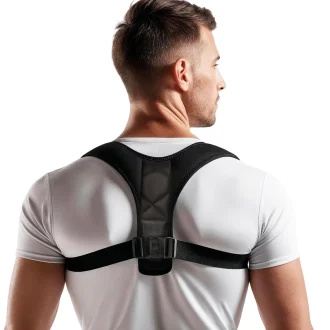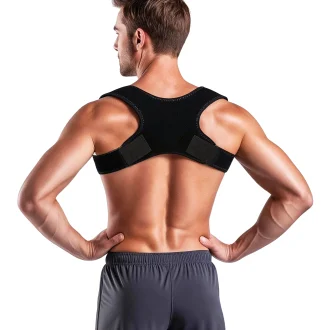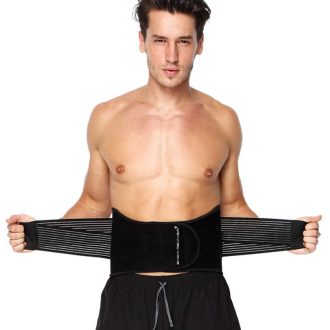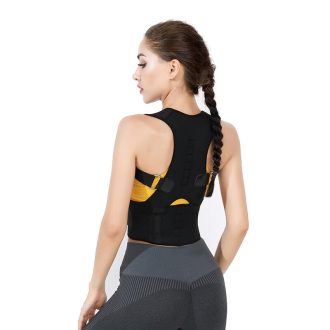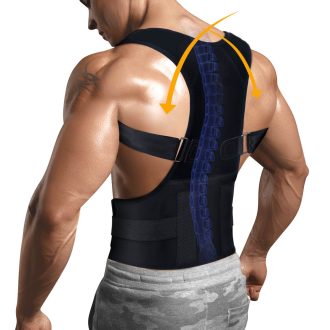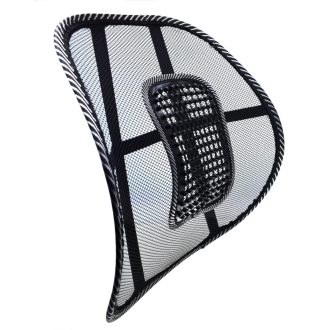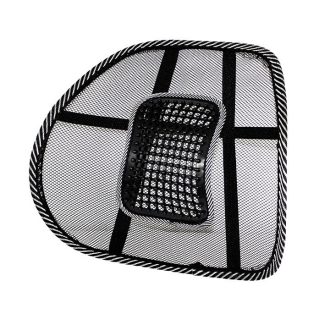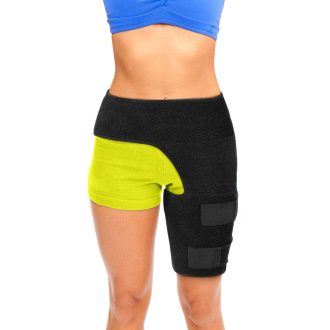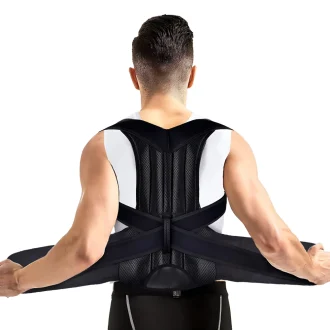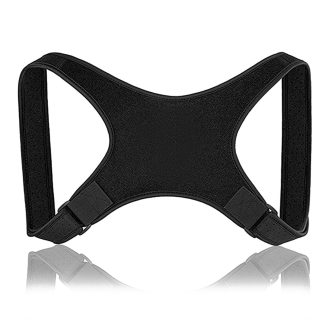No products in the cart.
Back Supports
Are you battling persistent back pain or hoping to stand taller and project more confidence? At NuovaHealth, we recognize these challenges and have developed a comprehensive selection of back supports, braces, posture correctors, and backrests to help relieve discomfort and enhance alignment.
Your back is a remarkably complex system, composed of 33 vertebrae, approximately 140 muscles, and numerous tendons, ligaments, and joints. It works tirelessly to support your posture, aid in movement, and shield your spinal cord—the main pathway between your brain and the rest of your body. When you experience an injury or ongoing pain in this vital area, daily life can become tremendously difficult. Our goal is to make a positive difference by offering high-quality solutions that help you move with ease and confidence.
The Importance of Good Posture
Imagine your body as a finely tuned machine. When one part is out of alignment, it can lead to a domino effect of issues. This is particularly true for posture. Poor posture habits, such as slouching at a work desk, craning your neck to look at a screen, or even carrying a heavy bag on one shoulder, can lead to biomechanical imbalances. This excessive strain and pressure can cause wear and tear, injury, and pain, manifesting in conditions like strains, disc injuries, sciatica, or even osteoporosis.
The Power of Proper Support
Good posture isn’t just about looking tall and confident; it’s a critical part of your overall health and well-being. But let’s face it, maintaining good posture can be a challenge, especially if you’re working long hours hunched over a laptop. That’s where our range of back supports, braces, and posture correctors come in.
Our back supports and braces work by providing targeted support and compression to your back, reducing strain and aiding in injury recovery. They are ideal for those suffering from back injuries or chronic pain. Our posture correctors, on the other hand, help realign your back and shoulder muscles, encouraging you to stand taller and relieving undue stress. And for those long hours at the desk? Our backrest chair supports are designed to help maintain your posture and reduce discomfort.
Recommended by Medical Experts: Injuries and Conditions
An integral reason many medical experts frequently recommend our range of back supports is their proven effectiveness in addressing a wide variety of injuries and conditions. They can be beneficial for individuals dealing with or recovering from:
Quality You Can Trust
Quality is at the forefront of everything we do. Each item in our range is made from premium, medical-grade materials, vigorously tested to ensure they are as supportive, comfortable, and durable as possible. They are designed to treat and prevent a range of back-related issues such as strains, herniated discs, scoliosis, and more.
So why not take a step towards better back health today? All our products come with a full 30-day money-back guarantee, so you have nothing to lose. Unleash your back’s true potential and see the difference our range of back supports and braces can make to your life. Trust us; your back will thank you.
Disclaimer:
The information provided here is intended for general educational purposes only and should not be considered a substitute for professional medical advice, diagnosis, or treatment. Always consult a qualified healthcare professional if you are experiencing persistent or worsening back pain.
- Consultation with a Medical Expert
• If you have ongoing or severe back discomfort, a thorough evaluation by a healthcare provider is strongly recommended to rule out potential underlying health problems.
• A doctor can diagnose the root cause of your pain, determine if it is related to muscle strain, spinal issues, or potentially more serious conditions such as various cancers (for example, cancers that have spread to the spine), infections, or other serious disorders.
• By identifying these conditions at an early stage, you can seek appropriate treatment promptly. - Importance of Proper Diagnosis
• Some health issues, including bone or spinal tumors, metastatic cancer, or vertebral fractures, may present with back pain. While bracing or posture correction may offer relief, these conditions often require specialized medical interventions.
• Ignoring severe or persistent symptoms can lead to increased discomfort, potential complications, or delayed diagnosis of serious conditions. - Appropriate Use of Back Supports
• Posture correctors, back braces, and chair support back rests are typically designed to offer extra stability, encourage proper alignment, and reduce strain on the back muscles.
• Individuals who may benefit include those with mild to moderate postural imbalances, certain spinal conditions as advised by a medical professional, or those recovering from less critical back injuries.
• Anyone with pre-existing conditions—especially cardiovascular, respiratory, or neurological disorders—should consult their doctor before using any support device. Also, certain pregnant individuals or those recovering from major surgeries might need specialized advice. - Safe and Responsible Wear
• Do not overtighten or wear these supports for extended periods without professional guidance, as it may lead to discomfort, skin irritation, or weakened supportive muscles over time.
• Follow the manufacturer’s instructions on how to properly fit, adjust, and clean your brace or support.
• Discontinue use and consult a medical expert if you experience unusual pain, swelling, numbness, or other concerning symptoms. - Our Commitment to Your Well-Being
• Your health is our priority. While our products aim to provide relief and help improve posture, they are not intended to replace individualized medical care.
• We encourage you to make an informed choice with the guidance of a qualified healthcare professional. Ensuring your back support aligns with your specific needs is essential for achieving the best possible outcome.
Always remember that addressing persistent back pain involves a combination of professional medical evaluation, potential lifestyle adjustments, and proper use of supportive products.
Posture Corrector Back Support
- 1x Back support posture corrector designed make you look taller and ease shoulder, neck and back pain by training you to overtime stand straighter with better posture
- For both men and women
- One size fits all with adjustable buckle to helps you find the perfect fit
- Improves posture by correcting common posture problems such as sway back, thoracic kyphosis, lumbar lordosis, rounded shoulders, slouching and forward head
- Easy to wear. Simply put the back support on like a backpack
- Discreet and non bulky – can be worn under or over your clothes
- Made from high quality soft touch fabric material that is both lightweight and extremely durable
- The secure adjustable straps prevent the back support from moving around whilst wearing
- Corrects sitting position helping to prevent back pain whilst sitting for long periods of time
- Ideal for general everyday use and wearing whilst playing sports or running
- Washable and odour resistant, features breathable holes to help better circulate air preventing sweat and keeping your back feeling cool
- Includes full 30 day money back guarantee if you are not 100% satisfied with your purchase!
£9.99£14.99inc VATBackReviver™ Posture Corrector Support Brace for Standing taller & easing back pain
- 1x BackReviver™ Posture Corrector Support Brace for Standing taller & easing back pain
- For both Men & Women
- One sizes fits most
- Improves your posture and supports your back in the correct position by pulling your shoulders back and realigning your spine to help alleviate pressure and strain off your spine and prevent excessive movement that can cause pain and injury
- Provides a good level of compression to boost blood flow to your upper back helping to ease aches and pains, reduce inflammation, swelling and promote healing of damaged tissue to speed up your injury recovery
- Daily wearing of the posture corrector helps overtime train the muscle memory in your back to help get rid of bad posture habits such as slouching, hunching forward, rounded shoulders and forward neck allowing you to effortlessly and naturally stand with better posture making you look taller with more confidence
- Recommended by Physiotherapists to help treat and ease a wide range of Upper Back, Shoulder and Neck injuries and conditions including Fibromyalgia. Clavicle Fractures, Cervical Neck Pain, Cervical Stenosis, Frozen Shoulder, Spinal Stenosis, Slipped Discs, Facet Syndrome, Neck and Shoulders Strains and Sprains, Osteoporosis and Arthritis
- Can be worn whilst exercising and running to protect your neck, shoulders and back from injury, reduce muscle fatigue and improve performance
- Ergonomically designed to be lightweight and as non-bulky as possible making this posture corrector the ideal choice for wearing discreetly underneath your regular clothes
- Made from skin friendly, breathable 4 way stretch materials and features moisture wicking technology and antibacterial properties that will help keep your upper back dry, sweat free and feeling cool and comfortable
- Adjustable soft padded shoulder straps prevent the posture corrector from digging into your arms and body and allow you to quickly and easily adjust the fitting and the level of support and compression that the posture corrector provides
- Includes a full 30-day money back guarantee!
£12.99inc VATBack Support Belt for Lower back pain
- 1x Back Support Belt specially developed by BackReviver™ to help relieve and treat back pain and injuries
- For both Men & Women
- Available in a range of different sizes featuring adjustable straps that wrap around your waist stopping the back support belt from moving around and allows you to quickly and easily adjust the level of compression and support that the belt provides
- Medium – 2.1-2.4 feet or 25.2 Inches – 28.8 Inches
Large – 2.4-2.7 feet or 28.8 Inches – 32.4 Inches
Extra Large 2.7-3 feet or 32.4 Inches – 36 Inches - Can be worn for the PRICE recovery protocol after sustaining a lower back injury to give you extra protection and compression and help improve and speed up your recovery
- Recommended for people suffering from a wide range of different injuries and conditions including Sciatica, Slipped discs, Herniated discs, Degenerative disc disease, Facet syndrome, Lumbar spinal stenosis, Scoliosis, spondylolisthesis, Muscle or ligament strain as well as Arthritis and Osteoarthritis
- Strategically placed back support rods have been added to support and correct the positioning of your lower back preventing movement and pressure which could cause strain and injury to your back
- Ideal for relieving pain and speeding up injury recovery- This waist belt provides compression designed to increase blood circulation helping to supply fresh oxygenated blood to your lower back which can help to speed up the natural healing process of damaged tissue, as well as reduce inflammation and swelling and provide targeted pain relief that will soothe aches and pains deep within your back and hips after sustaining an injury
- The slim non-bulky and lightweight design ensure this back support belt can be worn discreetly underneath regular clothing without excessive bulk
- Breathable ventilation holes and moisture wicking fabric helps to keep air circulated around your lower back keeping you sweat free, dry and feeling fresher for longer
- Great for wearing whilst playing sports, exercising and weightlifting or for general daily activities to help support and protect your back from strain and injury
- Includes a full 30 day money back guarantee!
£16.99inc VATMagnetic Back brace for Women
- 1x Magnetic back brace for women designed to help ease back pain and aches by improving your overall posture
- Sizes are as follows: Small = 80CM (for height under 150cm), Medium = 90CM (for height up to 160cm), Large = 100cm (for height up to 170cm),
XL = 110cm (for height up to 185cm), XXL= 120cm (for height 195+cm) - Recommended for poor posture, slipped discs, Sciatica, Scoliosis, Spondylolysis, Muscle or ligament strain, Arthritis and Osteoarthritis
- Ideal for providing extra support and protection to your lower, middle, upper back, shoulders and neck
- Helps improve your overall posture and prevent excessive pressure from damaging your back by supporting and realigning your spine and preventing slouching, hunching forward and rounded shoulders
- Features strategically placed magnets that provide soothing magnetic therapy to your back that ease back aches and pain deep within your back (Not recommended for those who use a pacemaker)
- Provides soothing compression that helps speed up and improve injury recovery by boosting blood flow to your back that will help reduce swelling and inflammation, ease aches and pain and speed up the natural healing process of damaged tissue
- Can be worn to help improve your posture and prevent common postural problems such as hunching forward, rounded shoulders and shoulders
- Features adjustable waist belt and buckled shoulder straps that keep the back brace comfortable and securely in place
- Ergonomically designed to be lightweight, slim and ideal for discreetly wearing underneath clothing
- Made from breathable materials with moisture wicking technology that draws moisture away from your body helping you to stay dry and sweat free for longer
- Includes a full 30 day money back guarantee!
Warning! Please note this item contains Magnets and so it can potentially interfere with pacemakers, defibrillators, and other medical implants that could be affected by magnets. Do not buy this item if you have an implanted medical device, we cannot be held liable for any damage caused wearing this product.£15.99inc VATMagnetic Back brace for posture
- 1x Magnetic back brace for posture designed to improve your overall posture and ease back aches and pain
- Sizes are as follows: Small = 80CM (for height under 150cm), Medium = 90CM (for height up to 160cm), Large = 100cm (for height up to 170cm),
XL = 110cm (for height up to 185cm), XXL= 120cm (for height 195+cm) - The fully adjustable waist belt and buckled straps helping you to find the most comfortable fit
- Straightens and realigns your spine helping to improve your posture and ease pressure off your back
- Recommended for helping to ease back conditions and injuries such as slipped discs, Sciatica, Scoliosis, spondylolisthesis, Muscle or ligament strain, Arthritis and Osteoarthritis
- Features strategically placed magnets that provide soothing magnetic therapy that targets and eases pain deep within your back (Not recommended for those who use a pacemaker)
- Provides soothing compression support that helps increase blood flow to your back helping to improve injury recovery by reducing swelling, inflammation and pain and speeding up the natural healing process of damaged soft tissue
- Made from lightweight and breathable materials with moisture wicking abilities that keep you feeling dry and sweat free all day long
- Includes a full 30 day money back guarantee!
Warning! Please note this item contains Magnets and so it can potentially interfere with pacemakers, defibrillators, and other medical implants that could be affected by magnets. Do not buy this item if you have an implanted medical device, we cannot be held liable for any damage caused wearing this product.£12.99inc VATBackrest for Office Chair
- 1x Backrest for Office Chair designed to ease back strain, aches and pain whilst sitting for long periods of time
- Ideal for easing back and neck strain, aches and pain and recommended for people suffering from back injuries and conditions such as Sciatica, Slipped discs, Facet syndrome, Lumbar spinal stenosis, Degenerative disc disease and Scoliosis
- Straps easily and securely around your office chair and can be adjusted in position and height that best suits your needs
- Provides targeted back support that helps improve your posture whilst sitting by realigning your spine into the correct position, preventing slouching and hunching forward when sitting and helps to ease pressure and strain off your spine preventing damage and injury to your back
- Features therapeutic beads that massage your spine helping to increase circulation to your back reducing numbness, inflammation whilst soothing back aches and pain
- Ergonomically designed to be lightweight, breathable and made from high quality materials that will stand the test of time
- Includes a full 30 day money back guarantee!
£10.99inc VATErgonomic Mesh Chair Backrest
- 1x Ergonomic Mesh Chair Backrest ideal for easing back aches and pain whilst sitting for long periods
- Can be fitted easily onto virtually any type of chair including Office Chairs, Wheelchairs and even gaming chairs for extra back support and comfort
- Designed to cushion and support your back in the correct position and helps to improve overall sitting posture by preventing slouching and hunching forward to ease pressure and strain off your back and prevent injury when sitting for long periods of time
- Recommended for people suffering from back injuries and conditions such as Sciatica, a Slipped disc, Degenerative disc disease, Lumbar spinal stenosis, Facet syndrome and Scoliosis
- Made from lightweight breathable mesh material that helps improve air circulation around your back keeping staying cool and sweat free throughout the day
- Features massaging nodes that massage your back and help to relieve tension and soothe aches and pains deep within your back
- Height and position can be easily adjusted using the secure straps that hold the backrest in place
- Includes a full 30 day money back guarantee!
£10.99inc VATErgonomic Backrest
- 1x Ergonomic Backrest designed to ease back aches and pains whilst sitting
- Easy to set up and adjust and will fit securely onto virtually any type of chair
- Cushions and supports your back in the correct position helping to improve your posture and reduce pressure on your back whilst seated for long periods of time
- Recommended for people who suffer from Sciatica, Slipped discs, Degenerative disc disease, Lumbar spinal stenosis, Facet syndrome or Scoliosis
- Features therapeutic nodes that massage your back and help improve blood flow, reduce swelling and inflammation and soothe aches and pains deep within your back
- Super lightweight breathable mesh that helps circulate air around your body keeping you feeling cool and fresh
- Includes a full 30 day money back guarantee!
£10.99inc VATLumbar Support Cushion
- 1x Lumbar Support Cushion designed to improve your posture and protect your back from injury when sitting for long periods of time
- Can be fitted onto virtually any type of chair quickly and easily with the secure strap that hold the Lumbar support in position at any angle
- Designed to improve your posture by supporting your back and aligning your spine to it’s natural curvature helping stop slouching and hunching forward whilst sitting for long periods of time
- Ideal for people who are suffering from Sciatica, Slipped discs, Facet syndrome, Lumbar spinal stenosis, Degenerative disc disease and Scoliosis
- Features Therapeutic beads that will massage and cushion your back helping to soothe aches and pain, reduce swelling and inflammation and prevent stiffness
- Made from lightweight breathable mesh material that helps to circulate air around your back keeping you feeling cool, dry and fresh
- Includes a full 30 day money back guarantee!
£10.99inc VATSciatic nerve brace
- 1x Sciatic nerve brace designed to ease Sciatica, leg hip and lower back pain
- For both Men & Women
- One size fits all (Max length of the waist 117cm, Max length of upper thigh 66cm)
- Two fully adjustable Velcro straps that keep the hip brace securely in place and allows you to adjust to the right support and fit with total ease
- Features Orthopaedic compression that supports and realigns your lower back, hips and waist helping to reduce pressure on the sciatic nerve
- Provides soothing compression that helps reduce aches, pain and swelling and improves blood flow to your Sciatic nerve helping to speed up the natural healing process
- Designed to improve stability, function and mobility of your hips and waist helping you to avoid future injuries
- Ideal for treating not just Sciatica but a whole range of different lower limb injuries including hip bursitis, a pulled groin, quad or hamstring, hip flexor injury, labral tear, Arthritis and SI joint pain
- Designed to be as lightweight as possible with a padded inside for extra comfort and protection making this Sciatic nerve brace ideal for wearing discreetly underneath your regular clothing for long periods of time without any discomfort
- Made from moisture wicking breathable materials that wick away moisture keeping you sweat free, dry and feeling fresher for longer
- Includes a full 30 day money back guarantee!
£16.99inc VATMagnetic Back Brace For Men
- 1x Magnetic Back Brace for Men purposefully built to ease pain and straighten your back
- Available in sizes Small, Medium, Large, XL & XXL
- Sizes are as follows: Small = 80CM (for height under 150cm), Medium = 90CM (for height up to 160cm), Large = 100cm (for height up to 170cm),
XL = 110cm (for height up to 185cm), XXL= 120cm (for height 195+cm). - Designed to straighten your back and correct common posture problems such as hunching, slouching and rounded shoulders
- Features strategically placed magnets that provide targeted magnetic therapy to your upper and lower back to soothe aches and pains (Not recommended for those who have a pacemaker)
- Provides targeted support that corrects the position of your upper and lower back this support will also provide soothing relief for aches and pains caused by bad posture
- Ideal for wearing for treating and preventing a wide range of back injuries and problems including a slipped disc, Sciatica, spondylolisthesis Muscle or ligament strain, Arthritis and Osteoarthritis
- Made from high quality materials that are lightweight, breathable and durable making this back brace perfect for wearing around the house, whilst running or working out at the gym
- The fully adjustable straps allow you to quick and easily adjust the back brace for the perfect fit
- Great for injury recovery this back brace will help to ease tension and pressure off your back and provide soothing compression that helps boost blood flow to your back and speed up recovery of weakened and damaged muscles
- Extremely comfortable to wear all day long. This back brace features padded arm straps that wont dig into your shoulders no matter how long you wear the brace for
- The discreet, slim non bulky design means that you can wear this back brace underneath your clothes without anyone knowing
- Includes a full 30 day money back guarantee for total customer peace of mind!
Warning! Please note this item contains Magnets and so it can potentially interfere with pacemakers, defibrillators, and other medical implants that could be affected by magnets. Do not buy this item if you have an implanted medical device, we cannot be held liable for any damage caused wearing this product.£15.99inc VATPosture Support Back Brace
- 1x BackReviver Posture Support back Brace— supports a more upright posture and helps reduce day‑to‑day strain across your upper and lower back; slim, comfortable, and easy to wear under everyday clothing
- Unisex adult fit: designed for men and women to wear comfortably under everyday clothing
- Sizes: Small (80 cm), Medium (90 cm), Large (100 cm), XL (110 cm), XXL (120 cm). Measure your waist at navel level; if you’re between sizes, choose smaller for a firmer hold or larger for a gentler fit
- Full‑length support system: a shaped back panel, an integrated lower‑back pad, and flexible stays guide a comfortable, fairly straight posture, spread pressure more evenly, and help limit deep bends and over‑arching—so everyday movements feel steadier
- Adjustable, even hold: dual‑pull straps tighten from both sides for a balanced fit you can change in seconds—go a touch firmer for standing, reaching, and light carrying; ease it for seated breaks
- Comfortable under clothing: low‑profile, ergonomic design moves with you and sits smoothly under workwear or casual clothes
- Comfort details that matter: padded shoulder straps help prevent digging; breathable, durable fabric with a quick‑dry lining manages warmth and moisture; smooth against the skin to reduce irritation
- Secure closures: strong hook‑and‑loop fasteners stay put during movement and release smoothly when you’re done
- Built‑in magnets (mid and lower back): add a calm, comforting feel for some users. Important: do not use if you have an implanted electronic or magnetic device, and do not use during pregnancy
- When to use for best results: wear it at the times your posture tends to slip—longer sitting or standing, desk work, light chores, short drives, and reach tasks—to help you keep your back fairly straight (not slumped, not over‑arched). Start with short sessions and add regular movement breaks to reinforce good habits
- What it can help with: can reduce slouching and rounded shoulders, support tired or weakened muscles, and may ease day‑to‑day strain linked to common back issues such as muscle strain, disc‑related low‑back ache, sciatica‑type leg symptoms, spondylolisthesis, and lower‑back osteoarthritis. Use as an add‑on to active care, not a stand‑alone cure; results vary
- Not a medical device: this brace supports posture and comfort but does not diagnose, treat, cure, or prevent disease
- Peace of mind: 30‑day money‑back guarantee—try it and return within 30 days if it isn’t right for you (fair‑use policy applies)
Warning! This item contains in‑built magnets and may interfere with pacemakers, defibrillators and other implants. Do not use if you have any implanted medical device or are pregnant. Adults only. Do not use over broken skin, after recent spinal surgery, with a suspected fracture, or with severe osteoporosis at high fracture risk. Use at your own risk; we cannot be liable for harm from use contrary to this warning.£12.99inc VATBack Support Brace for Poor Posture, Hunchback, Spine Misalignment & Rounded Shoulders
- 1x Back Support Brace for poor posture, thoracic kyphosis, lordosis, hunchback, spine misalignment & Rounded Shoulders
- For both Men & Women
- Available in sizes Small, Medium, Large, XL & XXL, 3XL and 4XL with two easy to use adjustable straps help you find the right support and fit for you.
- The maximum length of the belt are as follows measuring below the rib cage and around the stomach area.
- Medium 75-85cm 29.5-33.5 Inches
Large 85-95cm 33.5-37.4 Inches
XL 90-105cm 35.4-41.3 Inches
2XL 100-110cm 39.4-43.3 Inches
3XL 105-115cm 41.3-45.3 Inches
4XL 110-120cm 43.3-47.3 Inches - Made from lightweight breathable material and features a padded lining for extra comfort
- Features two flexible supportive rods that help to keep your spine straight and support your back and shoulders in the correct position
- Ergonomically designed to help improve your posture reducing tension and pressure off your back
- Provides soothing compression to help ease shoulder, lower and upper back pain
- Great for treating and preventing common back problems and injuries including Slipped disc, Sciatica, Facet syndrome, Lumbar spinal stenosis
- Includes a full 30 day money back guarantee if you are not 100% satisfied with your purchase!
Price range: £12.49 through £15.99inc VATUpper Back Support
- 1x Upper back support posture corrector for improving bad Posture and easing Shoulder, Back, and Neck Pain
- Ergonomically designed to correct posture and ease pressure off your back
- Provides compression that helps to improve circulation around your back easing pain and speeding up recover of back injuries
- Ideal for treating and preventing a wide range of back problems and injuries including Sprains and strains, Herniated & slipped discs & Fractured vertebrae
- Suitable for Men, Women and Children
- Made from strong yet lightweight neoprene material
- One size fits all – Easy to adjust and use with a secure Velcro strap and sturdy adjustable side buckles to find the right fit for you
- Breathable holes helps better circulate air around your back keeping you feeling fresh and sweat free
- The Non bulky and discreet design makes this posture corrector ideal for wearing comfortably underneath regular clothing
- Includes a full 30 day money back guarantee if you are not 100% satisfied with your purchase!
£12.99inc VAT
